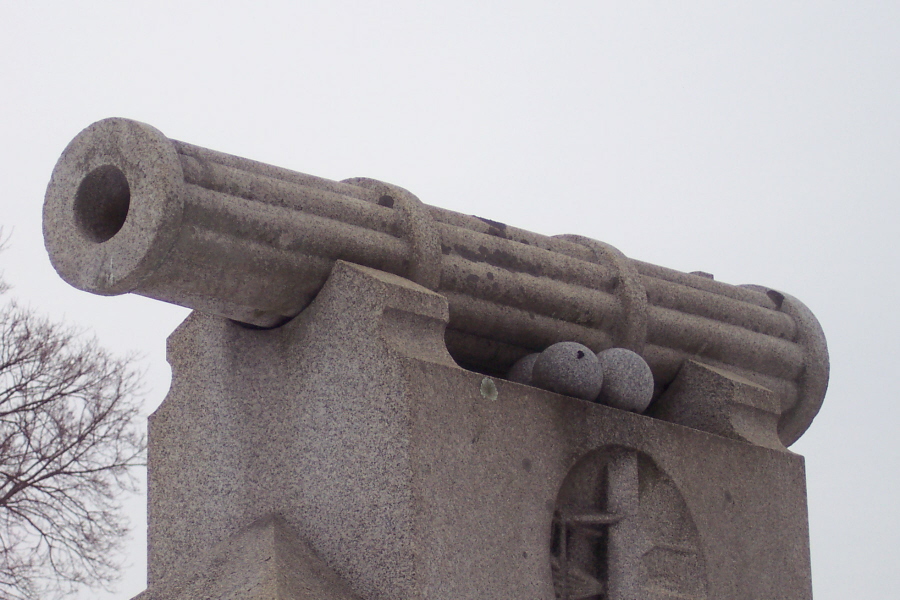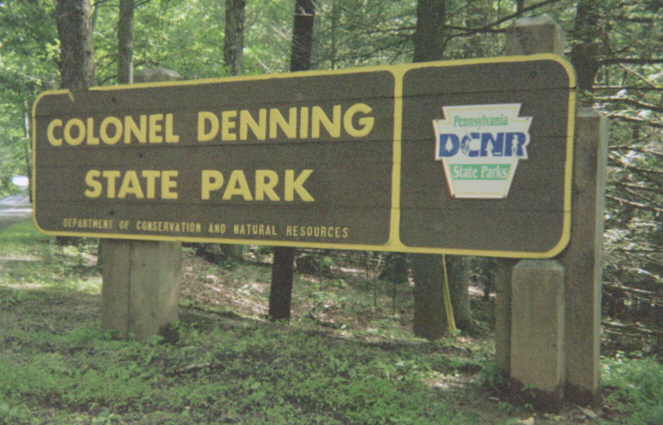Pennsylvania has a fine system of state parks, one of the largest in the nation. Several parks are named for important persons in the history of the Commonwealth or of the area in which the park is located. Gifford Pinchot State Park for the former governor, Maurice K. Goddard State Park for the long time head of the park and forestry agencies of the state, Shikellamy and Bald Eagle State Parks for colonial native-American leaders to name a few. Some parks are named for perhaps as important but surely less well-known figures. Driving north from the Cumberland County town of Newville on PA route 233, will bring you to one of these - COLONEL DENNING STATE PARK, a small woodland gem at the base of Conococheague Mountain.
William Denning's story is as much conjecture as fact, but it is an interesting tale nonetheless. He played a small but significant part in freeing the American colonies from the yoke of British tyranny. Raised in Chester County, Denning was probably born in 1736, although the monument where he is buried says 1737. He took up blacksmithing, the art of making useful things from iron, as a young man and became known as the Brandywine Blacksmith. Property records show that he and his wife owned land in Willistown Township. After the adoption of the Declaration of Independence, William joined the Continental army. He may have joined in New Jersey, it may have been in Philadelphia - there are colonial records to support both versions. He may have fought with General Washington at the battles of Trenton and Princeton in New Jersey. He may have been wounded at Princeton. He may have been at the Battle of Brandywine in September 1777. One can take their pick. What appears more clearly is that by early 1777 the Continental Congress directed the establishment of ordnance depots to manufacture muskets and cannon. One of these was at the town of Carlisle, where the army post would become known as Washingtonburg. The other was at Springfield, Massachusetts. General Washington directed his commanders to seek out men in their ranks who had the skills to make weapons. William Denning's blacksmithing skills soon resulted in his assignment to the company of "artificers" (makers of artillery) that was formed at Washingtonburg. He would serve for at least the next three years supervising the production of iron cannon there.
So what was so special about the cannons that William Denning helped to make for the Continental Army? Most cannon of the time, and for thousands of years, had been cast in molds, usually of iron or brass. As a blacksmith, Denning's skills at forging iron pieces and welding them together led him to a new idea. Denning's cannons were made of long strips of wrought iron, refined from the cast iron chunks or "pigs" that came from the iron furnace. These strips, called "gads", were the length of the cannon to be made. Formed around an iron mandrel which was the diameter of the cannon's bore, these gads were heat welded together by the time honored practice of hammering the heated iron until the pieces fused. To strengthen the cannon and keep it from exploding when fired, iron bands encirled the fused gads. At least three bands were used - one at the muzzle end, one in the middle, and one at the breech end of the cannon tube. Denning's cannons were four and six pounders, so named for he weight of the solid iron ball that they fired. He attempted to make larger ones, but the much higher heat needed was hard to achieve and workers couldn't stand to be near it. Years later, Robert Middleton, who had worked with Denning at Washingtonburg, recalled that the heat was so great when they tried to make a twelve-pound cannon that it melted the lead buttons on their shirts! It is unclear how many of this type cannon were produced at Washingtonburg, how well they performed, and why more of this type weren't made then and later.
No known example of these Denning cannons is known to exist today, but for years a story circulated that England's Tower of London museum had one that had been captured at the Battle of Brandywine. No less a personage than Robert Todd Lincoln, son of the President, when he was Ambassador to Great Britain, went to the Tower to see if indeed such a cannon was there. He was unable to find one. Responding to similar inquiries years later, Tower officials deny that they ever had such a cannon in their collections.
Following his service in the Revolution, Denning stayed in Cumberland County, settling near the town of Newville with his wife Mary and their two children, James and Mary (called Polly). He continued to practice the Blacksmith trade for the rest of his life, passing away on December 19, 1830, at the age of 94. It was claimed by "responsible persons" that a cannon constructed by him "was used on this particular occasion." William's son James, a veteran of the War of 1812, and his daughter Polly are buried next to him at the old Big Spring Presbyterian Church in Newville. In 1889, the Pennsylvania Legislature approved the sum of $1000.00 for a monument to mark his grave. This monument, of Vermont granite, can be viewed at the cemetery. It was unveiled on November 6, 1890, amid much pomp and ceremony. Governor James Beaver was a featured speaker; there was a cornet band, a parade by Civil War veterans as well as by the local chapter of the Patriotic Sons of America. The actual unveiling was done by local blacksmith Joseph McDermond, whose father had known William Denning. Upon its top is a granite version of one of William's wrought iron cannons. The cannon fittingly points east, toward England.
The inscription on the monument, reads: "ERECTED BY THE STATE OF PENNSYLVANIA IN MEMORY OF WILLIAM DENNING, THE PATRIOTIC BLACKSMITH AND FORGER OF WROUGHT-IRON CANNON DURING THE REVOLUTIONARY WAR BORN 1737 DIED 1830 "
Which brings us back to the State Park, created in the early 1930s, although the area had been a "public camp" on the Tuscarora State Forest for at least 10 years by then. The names "Denning Camp" and "Doubling Gap" were and still remain local names for what is now the state park. So why was the park named for William Denning? District Forester Benjamin McPherson, writing in 1926, stated, "I have not found any one able to connect Denning's name with Doubling Gap, or any one able to say that he ever lived in that section, however, I do not see any objection to our naming the camp Denning Public Camp." Another letter to McPherson from a Department of Forest and Waters official stated that the name for the park was suggested by Pennsylvania folklorist Henry Shoemaker, "as a recognition of the services performed by William Denning." District Forester McPherson wrote that Denning reportedly lived along the Conodoguinet Creek between Newville and Doubling Gap. Historian F. W. Beers, in his "Early History of Cumberland County", said, "About two miles from Newville, in Mifflin Township, lived William Denning, an artificer in the army during the Revolution. He is the only man who ever made a successful attempt to manufacture a wrought iron cannon."
It is highly improbable that William was ever a Colonel, and it is only in the name of the state park that this title is connected with him. Early New Jersey records note him as a Lieutenant. Strohm's history notes that William enlisted in a company in Chester County "of which he was a second Lieutenant." Yet comprehensive listings of Revolutionary officers compiled after the war do not mention his name. A bronze tablet placed at the Big Spring Presbyterian Church in Newville by the Cumberland County Chapter of the DAR has the names of 9 Officers, 1 Sergeant, and 14 Privates. William Denning is listed as one of the Privates. An "Index To Revolutionary War Service Records," transcribed from records in the National Archives lists two William Dennings. One was an infantryman from New England; the other "served as Sgt. under the Commissary Gen'l in the Military Stores Dept." It is this second William who is likely the subject of this tale. Army pension records, completed long after the war, list him as a Private, but this information came from William's own 1819 application for an old-soldier's pension. He himself stated his rank as Private, and did not note service at Trenton or Brandywine, or that he was wounded. Surely in applying for such pension he would have played up his battle involvement and wounding, wouldn't you think? He was awarded a pension of $8.00 per month. A second application was submitted in 1820, presumably trying for an increase in the amount. What resulted from this second application remains unknown. Most other sources and army records note him at the rank of Sergeant, and this is the rank that has been accepted by historians.
Following his war service, William lived some fifty years in the Newville area, passing away at the age of 94. He had come to be a venerated "old soldier" of the Revolution, fond of telling of his exploits a half century earlier, and of the hardships and privations endured by the Continental army in a way that was said to bring tears to the eyes of his listeners. Did he, among these recollections, promote himself a rank or so, or did he simply acquire the title of Colonel from his admiring friends, as so often happened to old Civil War veterans a few generations later? Pennsylvania folklorist Henry Shoemaker suggested Denning's name for the camping area and park. Shoemaker was well known for inventing history when it suited his purposes, so it may well have been he who promoted Sergeant Denning to Colonel. So there you have it, at least for now, until better sources come to light - the story of Private, Sergeant, Lieutenant, Colonel William Denning. Whatever his rank, William Denning provided a great service to his country in a time of need, and it is altogether fitting and proper that his memory should live on in the name of one of Pennsylvania's fine state parks.
A photograph of his grave monument, and a close-up of the blacksmith's forge depicted on it are shown below. The third photograph is of the DAR plaque at the cemetery listing "Private" William Denning as one of the many Revolutionary War soldiers buried there.
Although local histories give credit to Denning as the only person to make a wrought iron cannon, examples of these weapons are noted in accounts of warfare dating back to ancient China. A gigantic example of one, dubbed "Mons Meg," dating from the mid-1600s, is on display at Edinburgh Castle in Scotland. Even when reinforced, they had a great propensity to burst upon firing, and were most successful in smaller bore sizes. A 1900 book by Benjamin M. Nead entitled, "Waynesboro: The History of a Settlement In the County Formerly Called Cumberland", gives equal credit to Denning and to John Bourns, whom he states also made wrought-iron cannon at his forge "in the shadow of South Mountain," for making such cannons during the Revolutionary period. Paulson's Daily Advertiser, a Philadelphia newspaper, carried William's obituary, which in turn prompted a letter to state that Philadelphia blacksmith Samuel Wheler had also manufactured wrought iron cannon. In 1890, J. W. Strohm authored a small book entitled, "The Life and History of William Denning, the Revolutionary War Hero," Published by the Times Steam Print in Newville PA., and available at the Shippensburg University library, it is compiled mostly of the "knowledge from several aged persons," who in turn probably got their memories from the aged reminiscences of an equally aged William Denning. It disappointingly sheds little factual light on his life.
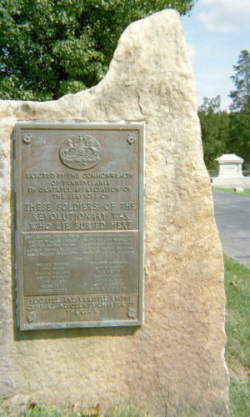 |
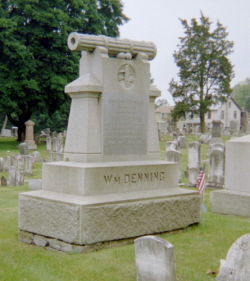 |
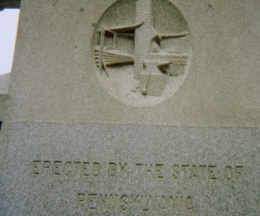 |
